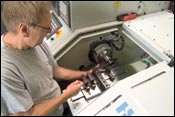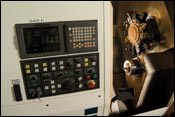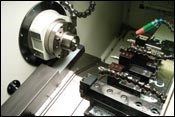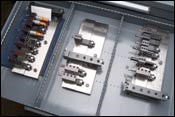Want To Do Medical Work? Set Up To Perform
This Midwest manufacturer has found its niche in machining parts for the medical industry. Much of its success is attributable to its efficient use of single-spindle CNC turning centers. However, the company prefers to talk about what happens when the tool touches the metal, and let the results speak for themselves.
This Midwest manufacturer has found its niche in machining parts for the medical industry. Much of its success is attributable to its efficient use of single-spindle CNC turning centers. However, the company prefers to talk about what happens when the tool touches the metal, and let the results speak for themselves.
Paul Prikos, vice president, X-L Engineering Corp., pulls no punches: When the backbone of an operation is in the medical field, it must be able to perform perfectly and repeatably. Tolerances must be hit right on the nose, and surface finishes must be created that would make most companies shiver.
Featured Content
“In medical, it’s all about cosmetics—the look and feel of the part,” he says. “This is not to say that in other fields the appearance of the part isn’t important—it is. After all, we do work in aerospace, defense, electrical, hydraulics and pneumatics, and these guys want good-looking parts, too. However, medical is something else entirely different. They want an appearance that compares—or exceeds comparison—to the finest automotive detail, for example.”
About X-L
Although machining has been going on under the X-L name since 1943, Ralph Prikos, former president, bought the business in 1973. There are two plants: one in Niles, Illinois, and one in Elk Grove, Illinois. Each occupies about 2,000 square feet. There are about 76 employees, of which 60 are directly employed in production.
“The industries we serve primarily are medical, although we do some aerospace work,” Paul Prikos explains. “The materials we process are steel, stainless, heat-treated steel. Actually, there isn’t a material that jumps out at me that we wouldn’t tackle. And I repeat—all this work is very tight-tolerance work with extreme finishes.
“Our growth plans right now are for about 10 percent a year. Our annual revenues are just less than $10 million. So as you can see, we’re relying on continued growth in the medical industry. And from what we can tell, it’s there. They’re doing some amazing things in medical.”
Medical Examples
Mr. Prikos sites a particular medical job to support his views about this industry. “We machine a medical housing, which holds transmission components for orthopedic instruments. There are a lot of very close-tolerance bores on the interior of the part, and what’s nice about running it through our single-spindle CNC turret-tooled lathe (8-inch chuck) is that after you’ve turned, drilled and bored on one side of the part, you can transfer to the subspindle and do all your back-end work on the same part.”
He continues, “If you were to attempt this without a subspindle, you would have to remove the part manually and turn the part 180 degrees and possibly re-fixture it in the machine to finish it there. This part requires milling on two sides, which can also be done in the same process on the turning center. It brings three processes down to one. This is probably one of our larger parts—3.00 inches in length with a diameter of 1.125 inches.”
Another medical job that X-L produces runs on a different turning center and consists of drives and shafts for power tools in medical applications. “We’re using this machine as part of a cellular setup. It’s the second lathe in a lathe/lathe/mill cell,” Mr. Prikos explains. “What we particularly like about the machine tool is its gang-type tooling plate that holds all the tools. We can remove the entire plate, save the job with all the tool settings unmoved, put in a different preset tooling plate for the next job, touch off the new plate, and we’re up and running our next job. As far as setup time reduction goes, when you change the tooling in and out that fast, it dramatically reduces setup time.” Mr. Prikos notes that these parts are all stainless steel, while some are heat-treated stainless, which is even tougher on the machine.
“Working with these materials requires a rigid, reliable and precise machine, and that’s what we have in the gang tool lathe. This is why we ordered two in the last year.”
Setup Times
It is difficult to talk about setup times for the turret-tooled and the gang-tooled turning centers, according to Mr. Prikos. “It really depends,” he says. “With the ability to preset the gang tool plates off-line and interchange them, it’s usually 3 minutes or less to change-over.
“If you’re running a complex part on the turret machine, you might be looking at 10 to 15 minutes. Some parts lend themselves to the tooling scheme on a turret machine where you have a number of features and you want to do the job, start to finish, in one machine. All in all, when short cycle times are coupled with quick change-overs, the combination is unbeatable,” he adds.
Multifunction Fits
The multifunction capability of the turret machines is well designed for the parts that X-L is running. “Most of our parts are smaller, and the spindle size permits us to run stock diameters from 1.625 inches to 2 inches. Using a collet, we can chuck parts in the machine, and the spindle runout and concentricity are right on the money.”
Another way to look at the machine’s capability is to ask how many axes the machine has. “When you’re talking about axes, you’re usually talking about milling,” Mr. Prikos explains. “With this machine and all its various functions, one of which is milling, how many axes do we have? With the live tooling, the machine is typically turning a piece, and when you go to mill the piece, the machine stops, and then the milling tool will start machining. The list of operations that can be performed—milling, cross- or end-milling/drilling, angular drilling, off-center milling/drilling, 3D contouring—gives multi-machine functionality on a single platform. With the added capability of live tooling and subspindle backworking, this much is certain: We appreciate being able to get pieces complete off the machine.”
For its workhorse, X-L has purchased two gang tool machines within the past year. “What we’ve found is that because of the ease of use, we wound up running so many things through the gang tool that it was backing things up, and it was clear to us that we needed another,” he adds.
Uptime
Uptime has been “considerable” for the company, according to Mr. Prikos. The machines are virtually always running. “Being so easy to set up, the gang tool machine is obviously very good, and the uptime is great,” he explains. “With the more complex turret machine, more goes into programming this more complicated machine. But the uptime has been fantastic, and the service, when we need it, is always there right away.”
Building On Strength
These machines have kept X-L Engineering competitive and have allowed the company to grow stronger in the medical field. It has taken 10 to 15 years to really understand what the medical industry demands, according to Mr. Prikos. “It wants tolerances in the tenths and finishes (which are spelled out on the print) of 16 to 32 rms, and they won’t accept anything less. Why should they?”
RELATED CONTENT
-
Dry Swiss Machining in Medical
Continuing to build its reputation for creative solutions, this multi-faceted medical device component manufacturer took its Swiss machining operations to a new level to meet a customer’s market demands.
-
Tooling Up for Micromachining
Choosing the right tools and matching them to the correct operations and process techniques for micromachining applications is critical to success in this burgeoning market.
-
German Project Yields Three New Medical Machining Processes
Recent research has resulted in a new mix of high-speed turn whirl milling, polygon turning and rotational turning for manufacturing medical bone screws and out-of-round nails.












